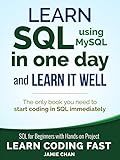Best SQL Tools to Buy in December 2025

Data Engineering with dbt: A practical guide to building a cloud-based, pragmatic, and dependable data platform with SQL



SQL Programming QuickStudy Laminated Reference Guide



SQL: Learn SQL (using MySQL) in One Day and Learn It Well. SQL for Beginners with Hands-on Project. (Learn Coding Fast with Hands-On Project Book 5)



RPG & SQL: Style and productivity: Guide to coding style, practices and productivity tools for the IBM i platform



SQL Pocket Guide: A Guide to SQL Usage



SQL for the AI Era: The Complete Handbook for Intelligent Data Systems, Machine Learning Readiness, and Real-World Automation


Calculating Bollinger Bands using SQL involves several steps. First, you need to calculate the moving average of a particular dataset over a specified period (e.g. 20 days). Next, calculate the standard deviation of the dataset over the same period. Finally, calculate the upper and lower bands by adding and subtracting two times the standard deviation from the moving average. By executing these calculations in SQL, you can create a table that displays the Bollinger Bands for the dataset. This can help traders identify potential overbought or oversold conditions in the market.
How to calculate the width of the Bollinger Bands in SQL?
To calculate the width of the Bollinger Bands in SQL, you will need to first calculate the upper and lower Bollinger Bands using the typical Moving Average and standard deviation calculations. Once you have these values, you can then subtract the lower band value from the upper band value to get the width of the Bollinger Bands.
Here's an example SQL query that demonstrates how you can calculate the width of the Bollinger Bands:
WITH Prices AS ( SELECT *, AVG(price) OVER (ORDER BY date ROWS BETWEEN 19 PRECEDING AND CURRENT ROW) AS sma_price, STDDEV(price) OVER (ORDER BY date ROWS BETWEEN 19 PRECEDING AND CURRENT ROW) AS std_dev_price FROM your_table ) SELECT date, price, sma_price, std_dev_price, sma_price + (2 * std_dev_price) AS upper_band, sma_price - (2 * std_dev_price) AS lower_band, (sma_price + (2 * std_dev_price)) - (sma_price - (2 * std_dev_price)) AS width FROM Prices;
In this query:
- Replace your_table with the name of your table that contains the price data.
- The sma_price column calculates the 20-day Simple Moving Average of the price.
- The std_dev_price column calculates the standard deviation of the price.
- The upper_band and lower_band columns calculate the upper and lower Bollinger Bands using the formula (SMA + (2 * SD)) and (SMA - (2 * SD)), respectively.
- The width column calculates the width of the Bollinger Bands by subtracting the lower band value from the upper band value.
You can adjust the period (20 in this example) and the number of standard deviations (2 in this example) according to your preferences and trading strategy.
How to apply Bollinger Bands in conjunction with other indicators in SQL?
To apply Bollinger Bands in conjunction with other indicators in SQL, you can create a database table that includes columns for the price data you want to analyze, as well as columns for the Bollinger Bands indicators and any other indicators you want to use.
First, you will need to calculate the Bollinger Bands themselves using a query similar to the following:
SELECT *, (SELECT AVG(price) OVER (ORDER BY date ROWS BETWEEN 19 PRECEDING AND CURRENT ROW) + (2 * STDDEV(price) OVER (ORDER BY date ROWS BETWEEN 19 PRECEDING AND CURRENT ROW)) AS upper_band, (SELECT AVG(price) OVER (ORDER BY date ROWS BETWEEN 19 PRECEDING AND CURRENT ROW) - (2 * STDDEV(price) OVER (ORDER BY date ROWS BETWEEN 19 PRECEDING AND CURRENT ROW)) AS lower_band FROM your_table;
Next, you can add columns for other indicators such as Moving Averages, Relative Strength Index (RSI), MACD, etc. and calculate them in a similar manner.
Once you have calculated all the desired indicators in your database table, you can then analyze the data set to identify potential trading opportunities. For example, you can look for instances where the price crosses above or below the Bollinger Bands, or where the RSI indicates overbought or oversold conditions.
By combining multiple indicators in this way, you can create more robust trading strategies and improve the accuracy of your trading signals.
What is the formula for calculating the Bollinger Bands in SQL?
There is no specific formula for calculating Bollinger Bands in SQL as it is typically calculated using statistical functions such as moving averages and standard deviations. However, here is an example query in SQL that calculates the 20-day Bollinger Bands for a given stock:
WITH price_data AS ( SELECT date, close_price, AVG(close_price) OVER (ORDER BY date ROWS BETWEEN 19 PRECEDING AND CURRENT ROW) AS sma, STDDEV_SAMP(close_price) OVER (ORDER BY date ROWS BETWEEN 19 PRECEDING AND CURRENT ROW) AS stddev FROM stock_prices ) SELECT date, close_price, sma AS middle_band, sma + (2 * stddev) AS upper_band, sma - (2 * stddev) AS lower_band FROM price_data
In this query, stock_prices is the table containing historical stock prices with columns date and close_price. The query calculates the 20-day simple moving average (SMA) and standard deviation for each row, and then calculates the upper and lower Bollinger Bands by adding and subtracting 2 times the standard deviation from the SMA.
Please note that the specific functions and syntax may vary depending on the SQL database you are using.
What is the significance of Bollinger Bands in technical analysis?
Bollinger Bands are a technical analysis tool that consists of a simple moving average line, an upper band, and a lower band. The significance of Bollinger Bands in technical analysis lies in their ability to provide traders with information about the volatility and potential price movements of a given asset.
The bands widen when volatility increases and narrow when volatility decreases, providing traders with a visual representation of market volatility. Traders typically use Bollinger Bands to identify potential buy or sell signals when the price of an asset reaches the upper or lower band, indicating potential overbought or oversold conditions.
Additionally, the middle band can act as a support or resistance level, with prices typically bouncing off of it during trending markets. Overall, Bollinger Bands are a versatile tool that can help traders identify potential trading opportunities and make informed decisions based on market conditions.
What is the difference between the upper and lower Bollinger Bands?
The Bollinger Bands consist of three lines: the upper band, the lower band, and the middle band. The upper band is a line that is typically two standard deviations above the middle band, while the lower band is typically two standard deviations below the middle band. Therefore, the main difference between the upper and lower Bollinger Bands is their position relative to the middle band, with the upper band being above the middle band and the lower band being below it. The bands are used together to help traders determine potential overbought or oversold conditions in the market.
